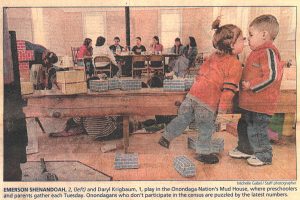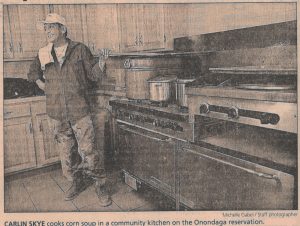
[As the 2020 US Census begins this spring, here is an article from 2001 regarding the Onondaga Nation’s position about the US Census]
Onondaga’s Say: That’s not us in your census
Syracuse Post Standard
By Mike McAndrew
March 21, 2001
There’s much merriment on the Onondaga Nation when the U.S. Census Bureau figures are announced every decade.
 Ten years ago (1991), the census claimed that there were 771 residents of the Nation’s territory and only 2 were Native American.
Ten years ago (1991), the census claimed that there were 771 residents of the Nation’s territory and only 2 were Native American.
Last week, when the 2000 Census figures were released, the bureau said the population nearly doubled to 1,473 residents.
It claimed the Onondaga Nation was home to 763 Native Americans, 631 whites, 25 African-Americans, 3 Pacific Islanders and 51 others who identified themselves as a mix of two traces.
“Oh my gosh. Where did they get that from? I know it’s not right,” said Wendy Gonyea, who works in the Nation’s communications office.
“Since 1973, only Native Americans have resided on the Onondaga territory,” Gonyea said.
“It’s really silly,” she said about the Census Bureau numbers.
As a nation, the Onondagas have declined to participate in the census for the past 40 years because they do not consider themselves U.S. citizens, they are not represented by Congress, and they do not accept federal Bureau of Indian Affairs money, said Sid Hill, Tadodaho or spiritual leader on the Onondaga territory.
“Few, if any, Onondagas fill out census questionnaires,” Hill said.
The population on the Nation remains a secret. Hill and several Onondaga Chiefs have declined to say how many people live there. Hill said the population is increasing but did not say if the Census Bureau’s figure of 1,473 residents is accurate.
Two Census Bureau officials, including the bureau’s manager of the American Indian and Alaskan Native Program, said Monday the government’s information about the nation south of Syracuse is based on information the Onondagas must have supplied. 
“We do not make up numbers,” said Arthur Dukakis, director of the Census Bureau’s Boston regional office. “This is what we were told.”
Sydnee Chattin-Reynolds, a member of the Blackfeet Nation, who is the Census Bureau’s top liaison to American Indian tribes, also offered that explanation, insisting residents of the Onondaga Nation must have identified themselves as whites, blacks, and Pacific Islanders.
Clark Billings, the former manager of the bureau’s Syracuse office, said last year that the bureau did not mail census forms to the Onondaga Nation or collect information in person because the Onondaga chiefs are opposed to the census.
On Monday, Billings declined to comment.
Dukakis said that the Census Bureau probably would not review its Onondaga Nation statistics unless the Onondaga Nation Council complained in writing.
“It’s unlikely the Onondaga’s will bother,” Hill said. “It doesn’t really matter to us.”
“We know who’s here,” said Awhenjiosta Myers, an Onondaga woman. “That’s all that matters.”
“We’re the Pacific Islanders.” JoAnne Powless laughed, pointing to herself and two other friends at the Onondaga Mudhouse preschool program.
“I have a Hawaiian shirt at home,” added Sonny Shenandoah, as he watched a group play at the the Mudhouse.
Oneida Nation representatives won’t talk about whether they encourage participation in the census. The Iroquois Confederacy nations have had a long-standing practice of not participating in the U.S. Census.
Despite the criticisms, Chattin-Reynolds said American-Indian tribes participated in the census in much greater numbers in 2000 than they did in 1990.
“We went from 12.2 percent under-counted on reservations in 1990 to 4.74 percent (in 2000),” Chattin-Reynolds said.
She said the Census Bureau invited the Onondaga Nation Council of Chiefs to a conference for tribal leaders in August 1999 in Mashantucket, Conn., but they did not attend.
[Note – In 2010, the Onondaga Nation also did not participate in the U.S. Census]
